Comprehensive Report on Sales Development for Toyota
VerifiedAdded on 2020/02/03
|15
|4393
|32
Report
AI Summary
This report provides a comprehensive analysis of sales development strategies, specifically focusing on the Toyota Company. It begins by examining key product components, including branding, packaging, quality, variety, warranty, design, and services, and how the product mix contributes to sales and profitability. The report then delves into the role of market segmentation, discussing structural, need-based, and sales effectiveness segmentation. It further explores the factors influencing buyer behavior, such as cultural and social factors, and assesses various advertising media for sales development. The report also evaluates the use of external merchandising to maximize customer volumes and assesses the influence of design and layout on customer spending. Additionally, it reviews internal merchandising materials, evaluates promotional activities, and examines personal selling techniques, the influence of operational design on sales revenue, and key principles for sales training programs. The report concludes with an overview of the key findings and recommendations for enhancing Toyota's sales development efforts.
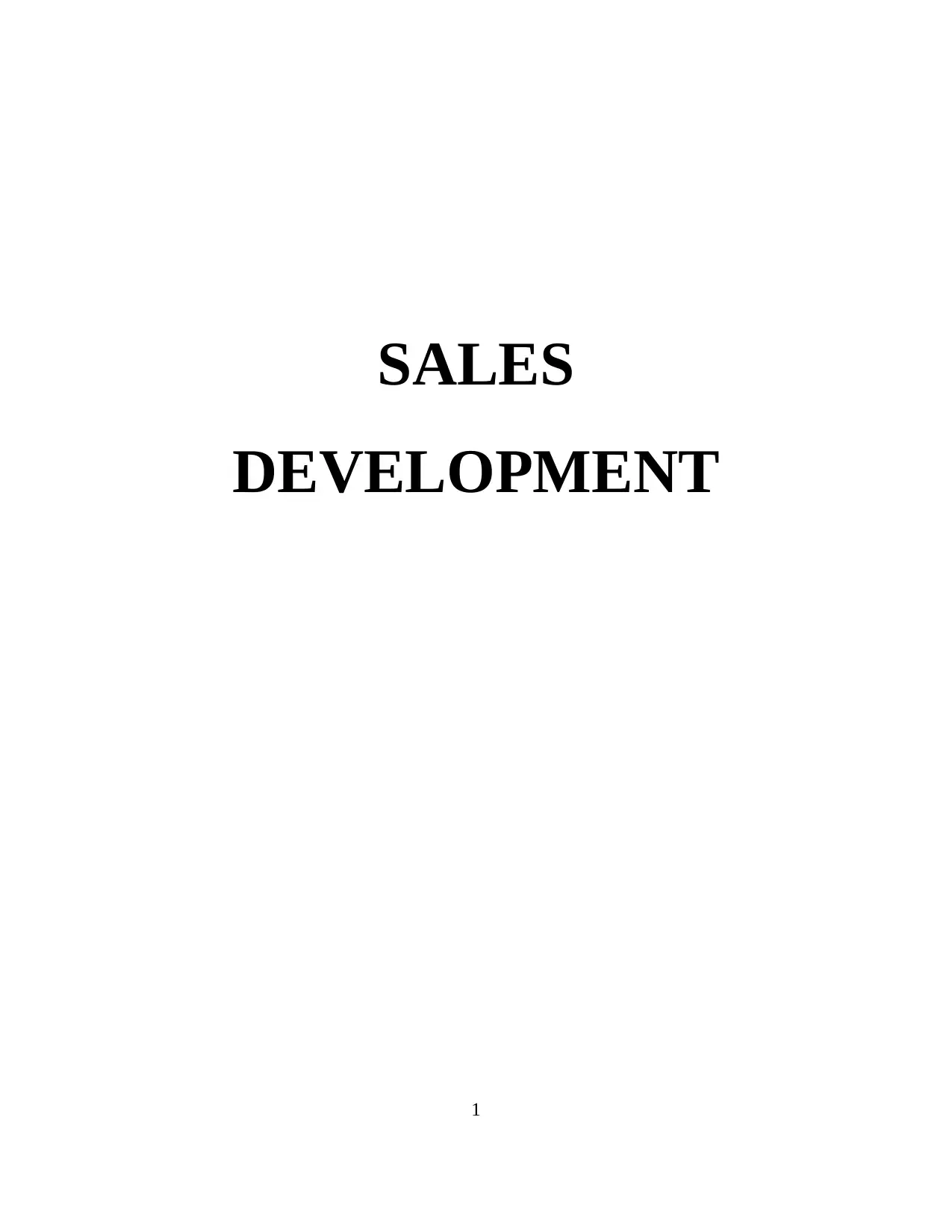
SALES
DEVELOPMENT
1
DEVELOPMENT
1
Paraphrase This Document
Need a fresh take? Get an instant paraphrase of this document with our AI Paraphraser
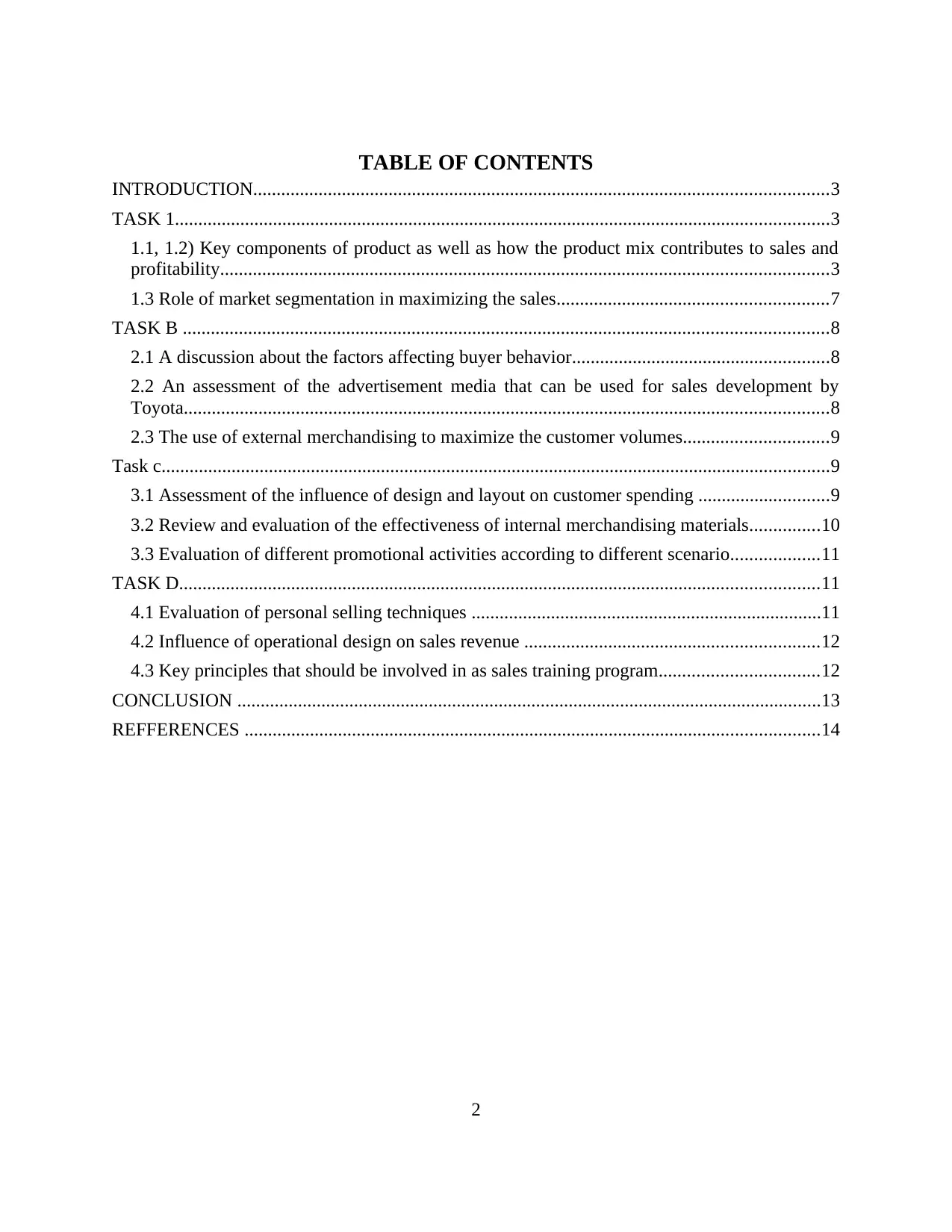
TABLE OF CONTENTS
INTRODUCTION...........................................................................................................................3
TASK 1............................................................................................................................................3
1.1, 1.2) Key components of product as well as how the product mix contributes to sales and
profitability..................................................................................................................................3
1.3 Role of market segmentation in maximizing the sales..........................................................7
TASK B ..........................................................................................................................................8
2.1 A discussion about the factors affecting buyer behavior.......................................................8
2.2 An assessment of the advertisement media that can be used for sales development by
Toyota..........................................................................................................................................8
2.3 The use of external merchandising to maximize the customer volumes...............................9
Task c...............................................................................................................................................9
3.1 Assessment of the influence of design and layout on customer spending ............................9
3.2 Review and evaluation of the effectiveness of internal merchandising materials...............10
3.3 Evaluation of different promotional activities according to different scenario...................11
TASK D.........................................................................................................................................11
4.1 Evaluation of personal selling techniques ...........................................................................11
4.2 Influence of operational design on sales revenue ...............................................................12
4.3 Key principles that should be involved in as sales training program..................................12
CONCLUSION .............................................................................................................................13
REFFERENCES ...........................................................................................................................14
2
INTRODUCTION...........................................................................................................................3
TASK 1............................................................................................................................................3
1.1, 1.2) Key components of product as well as how the product mix contributes to sales and
profitability..................................................................................................................................3
1.3 Role of market segmentation in maximizing the sales..........................................................7
TASK B ..........................................................................................................................................8
2.1 A discussion about the factors affecting buyer behavior.......................................................8
2.2 An assessment of the advertisement media that can be used for sales development by
Toyota..........................................................................................................................................8
2.3 The use of external merchandising to maximize the customer volumes...............................9
Task c...............................................................................................................................................9
3.1 Assessment of the influence of design and layout on customer spending ............................9
3.2 Review and evaluation of the effectiveness of internal merchandising materials...............10
3.3 Evaluation of different promotional activities according to different scenario...................11
TASK D.........................................................................................................................................11
4.1 Evaluation of personal selling techniques ...........................................................................11
4.2 Influence of operational design on sales revenue ...............................................................12
4.3 Key principles that should be involved in as sales training program..................................12
CONCLUSION .............................................................................................................................13
REFFERENCES ...........................................................................................................................14
2

INTRODUCTION
Sales development is a business process which aims at maximizing the sales of company.
Sales plays an important part in the functioning of organization as it helps in generating revenue
and ensures future sustainability of entity (Porter, 2014). Therefore, it can be stated that sales is
the heart of growth and prosperity of company. In this report, various aspects of sales
development will be studied in the context of Toyota Company. It is a leading automobile
company of Japan which is recognized for manufacturing more than 10 million vehicles every
year. It offers various products like luxury vehicles, commercial vehicles, automobile engines
etc. In this report, learning will be shown regarding the key components of the product as well
as how the product mix contributes to sales and profit. Further, factors affecting buyer behavior
will be discussed in this report. Thereafter, personal selling techniques will be evaluated.
TASK 1
1.1, 1.2) Key components of product as well as how the product mix contributes to sales and
profitability
Product refers to as an item, thought, procedure, information, commodity or service that
can be offered to a market for satisfying the needs or wants of customers. Toyota offers a wide
range of luxury, commercial and domestic use vehicles for large number of customers. Company
is first one to launch the Hybrid car concept with an aim of initiating the Eco-friendly
automobiles in the society. Total product offered by company consists of three elements such as
core, actual and augmented product. Core product refers to the portion of total product that
customer is buying in reality (Tsai and et.al., 2013). Actual product refers to brand name,
packaging, attributes, label, content and quality. Thereafter, augmented product refers to extra
services offered to customers who has purchased the offerings. Thereafter, components of
product can be as follows:
3
Sales development is a business process which aims at maximizing the sales of company.
Sales plays an important part in the functioning of organization as it helps in generating revenue
and ensures future sustainability of entity (Porter, 2014). Therefore, it can be stated that sales is
the heart of growth and prosperity of company. In this report, various aspects of sales
development will be studied in the context of Toyota Company. It is a leading automobile
company of Japan which is recognized for manufacturing more than 10 million vehicles every
year. It offers various products like luxury vehicles, commercial vehicles, automobile engines
etc. In this report, learning will be shown regarding the key components of the product as well
as how the product mix contributes to sales and profit. Further, factors affecting buyer behavior
will be discussed in this report. Thereafter, personal selling techniques will be evaluated.
TASK 1
1.1, 1.2) Key components of product as well as how the product mix contributes to sales and
profitability
Product refers to as an item, thought, procedure, information, commodity or service that
can be offered to a market for satisfying the needs or wants of customers. Toyota offers a wide
range of luxury, commercial and domestic use vehicles for large number of customers. Company
is first one to launch the Hybrid car concept with an aim of initiating the Eco-friendly
automobiles in the society. Total product offered by company consists of three elements such as
core, actual and augmented product. Core product refers to the portion of total product that
customer is buying in reality (Tsai and et.al., 2013). Actual product refers to brand name,
packaging, attributes, label, content and quality. Thereafter, augmented product refers to extra
services offered to customers who has purchased the offerings. Thereafter, components of
product can be as follows:
3
⊘ This is a preview!⊘
Do you want full access?
Subscribe today to unlock all pages.

Trusted by 1+ million students worldwide
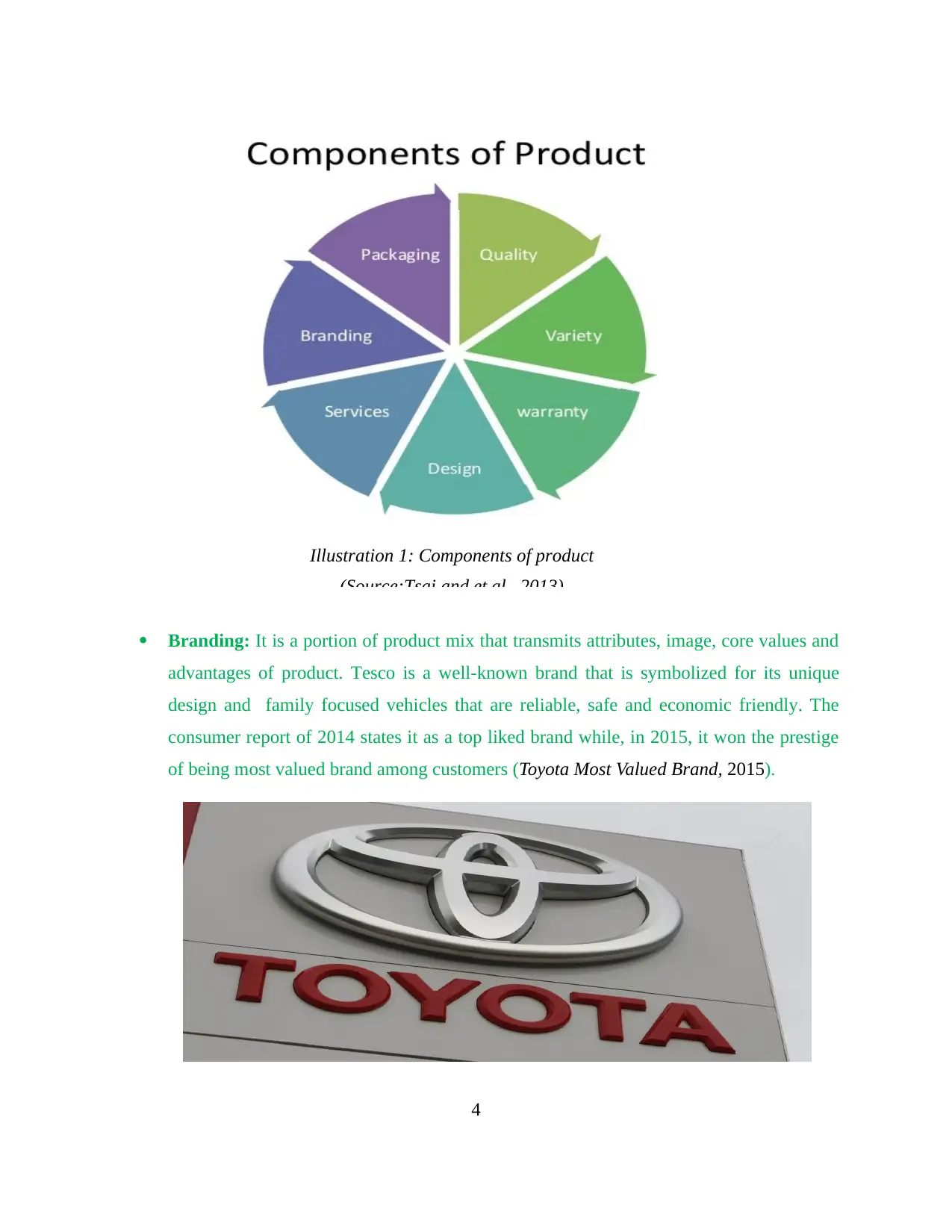
Branding: It is a portion of product mix that transmits attributes, image, core values and
advantages of product. Tesco is a well-known brand that is symbolized for its unique
design and family focused vehicles that are reliable, safe and economic friendly. The
consumer report of 2014 states it as a top liked brand while, in 2015, it won the prestige
of being most valued brand among customers (Toyota Most Valued Brand, 2015).
4
Illustration 1: Components of product
(Source:Tsai and et.al., 2013)
advantages of product. Tesco is a well-known brand that is symbolized for its unique
design and family focused vehicles that are reliable, safe and economic friendly. The
consumer report of 2014 states it as a top liked brand while, in 2015, it won the prestige
of being most valued brand among customers (Toyota Most Valued Brand, 2015).
4
Illustration 1: Components of product
(Source:Tsai and et.al., 2013)
Paraphrase This Document
Need a fresh take? Get an instant paraphrase of this document with our AI Paraphraser
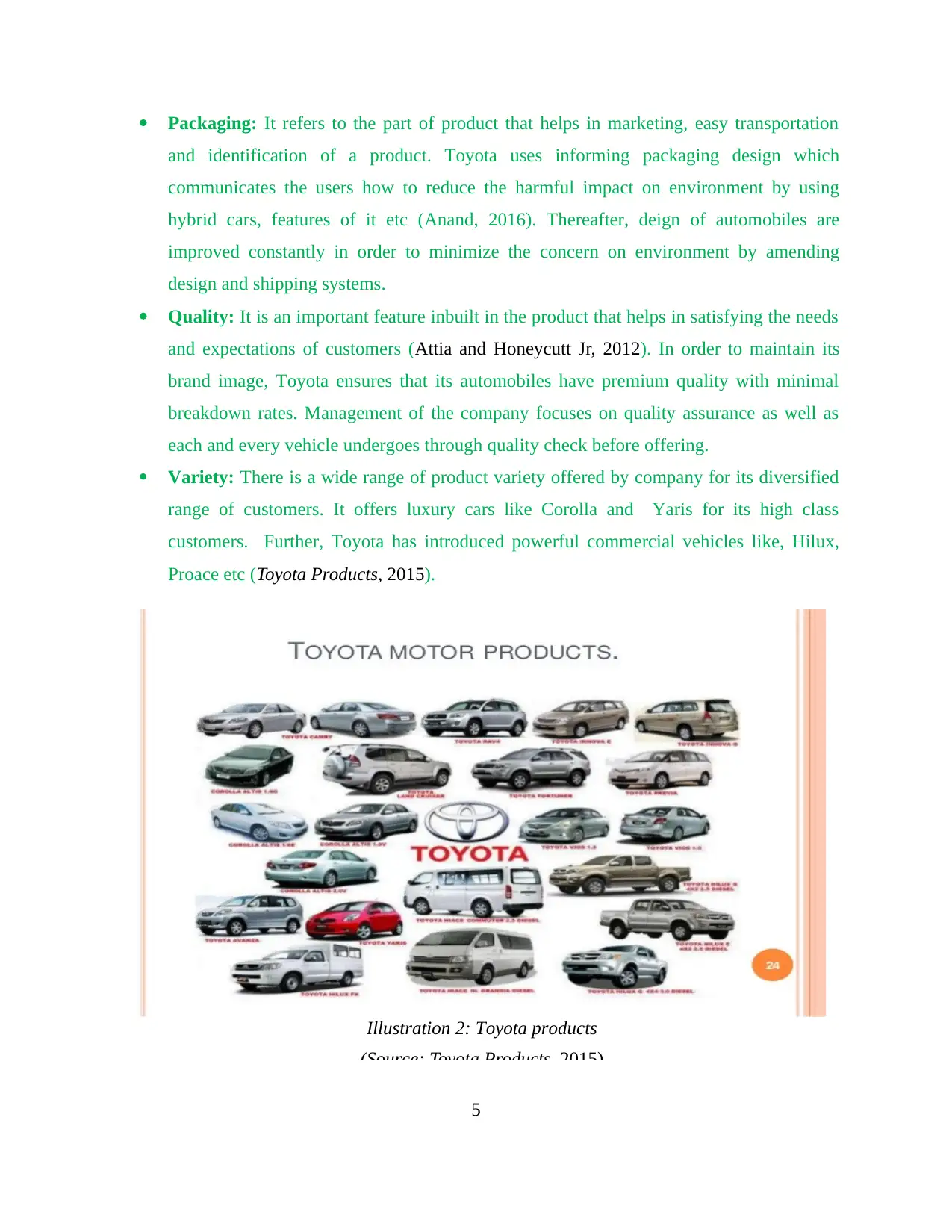
Packaging: It refers to the part of product that helps in marketing, easy transportation
and identification of a product. Toyota uses informing packaging design which
communicates the users how to reduce the harmful impact on environment by using
hybrid cars, features of it etc (Anand, 2016). Thereafter, deign of automobiles are
improved constantly in order to minimize the concern on environment by amending
design and shipping systems.
Quality: It is an important feature inbuilt in the product that helps in satisfying the needs
and expectations of customers (Attia and Honeycutt Jr, 2012). In order to maintain its
brand image, Toyota ensures that its automobiles have premium quality with minimal
breakdown rates. Management of the company focuses on quality assurance as well as
each and every vehicle undergoes through quality check before offering.
Variety: There is a wide range of product variety offered by company for its diversified
range of customers. It offers luxury cars like Corolla and Yaris for its high class
customers. Further, Toyota has introduced powerful commercial vehicles like, Hilux,
Proace etc (Toyota Products, 2015).
5
Illustration 2: Toyota products
(Source: Toyota Products, 2015)
and identification of a product. Toyota uses informing packaging design which
communicates the users how to reduce the harmful impact on environment by using
hybrid cars, features of it etc (Anand, 2016). Thereafter, deign of automobiles are
improved constantly in order to minimize the concern on environment by amending
design and shipping systems.
Quality: It is an important feature inbuilt in the product that helps in satisfying the needs
and expectations of customers (Attia and Honeycutt Jr, 2012). In order to maintain its
brand image, Toyota ensures that its automobiles have premium quality with minimal
breakdown rates. Management of the company focuses on quality assurance as well as
each and every vehicle undergoes through quality check before offering.
Variety: There is a wide range of product variety offered by company for its diversified
range of customers. It offers luxury cars like Corolla and Yaris for its high class
customers. Further, Toyota has introduced powerful commercial vehicles like, Hilux,
Proace etc (Toyota Products, 2015).
5
Illustration 2: Toyota products
(Source: Toyota Products, 2015)

Warranty: It refers to the assurance provided by company to its customers that it will
repair or replace the product if required within a particular time frame. Toyota is assured
about its quality, therefore it provides 5 year warranty against mechanical default by
ensuring repair and replacement. It provides 12 year warranty against corrosion from
rust.
Design: It refers to the structure of product or system that plays an important role in
attracting customers. Toyota makes constant modifications in its design through using its
technically equipped engineering processes.
Services: In addition to product, company offers effective after sales services for its
product. It also provides guidance about how to operate various systems, insurance etc.
that can be taken by customer for its vehicles (Lapide, 2007).
Furthermore, product mix refers to range of products offered by company for sales. By
making viable change in product mix, company can ensure increase in sales and profits.
Company offers diversified range of products based on the needs and preferences of customers.
By increasing the number of products in product line such as family vehicles, company can
attract more customers and induce them to make purchase. This will further help in increasing
profit as well as sales of company (Anand, 2016).
1.3 Role of market segmentation in maximizing the sales
Market segmentation refers to division of total market in small parts as per the
preference, demand, interest and priorities of customers. It further involves planning and
implementing strategies to influence them. Company can target customers based on factors like
geographic, demographic, behavioral and psychographic. With the help of market segmentation,
company determines to whom they want to offer their products and services. This further helps
in determining the prices of offerings, modes of advertising and distribution in order to enhance
sales and revenue (Wedel and Kamakura, 2012). Therefore, segmentation helps organization in
taking strategic decision which influences its long term success and sustainability. In order to
maximize its sales and profit, Toyota can consider following segmentation levels:
Structural segmentation: With this aspect, company can make feasible business
investment decisions. Organization can identify fruitful business opportunities and
6
repair or replace the product if required within a particular time frame. Toyota is assured
about its quality, therefore it provides 5 year warranty against mechanical default by
ensuring repair and replacement. It provides 12 year warranty against corrosion from
rust.
Design: It refers to the structure of product or system that plays an important role in
attracting customers. Toyota makes constant modifications in its design through using its
technically equipped engineering processes.
Services: In addition to product, company offers effective after sales services for its
product. It also provides guidance about how to operate various systems, insurance etc.
that can be taken by customer for its vehicles (Lapide, 2007).
Furthermore, product mix refers to range of products offered by company for sales. By
making viable change in product mix, company can ensure increase in sales and profits.
Company offers diversified range of products based on the needs and preferences of customers.
By increasing the number of products in product line such as family vehicles, company can
attract more customers and induce them to make purchase. This will further help in increasing
profit as well as sales of company (Anand, 2016).
1.3 Role of market segmentation in maximizing the sales
Market segmentation refers to division of total market in small parts as per the
preference, demand, interest and priorities of customers. It further involves planning and
implementing strategies to influence them. Company can target customers based on factors like
geographic, demographic, behavioral and psychographic. With the help of market segmentation,
company determines to whom they want to offer their products and services. This further helps
in determining the prices of offerings, modes of advertising and distribution in order to enhance
sales and revenue (Wedel and Kamakura, 2012). Therefore, segmentation helps organization in
taking strategic decision which influences its long term success and sustainability. In order to
maximize its sales and profit, Toyota can consider following segmentation levels:
Structural segmentation: With this aspect, company can make feasible business
investment decisions. Organization can identify fruitful business opportunities and
6
⊘ This is a preview!⊘
Do you want full access?
Subscribe today to unlock all pages.

Trusted by 1+ million students worldwide
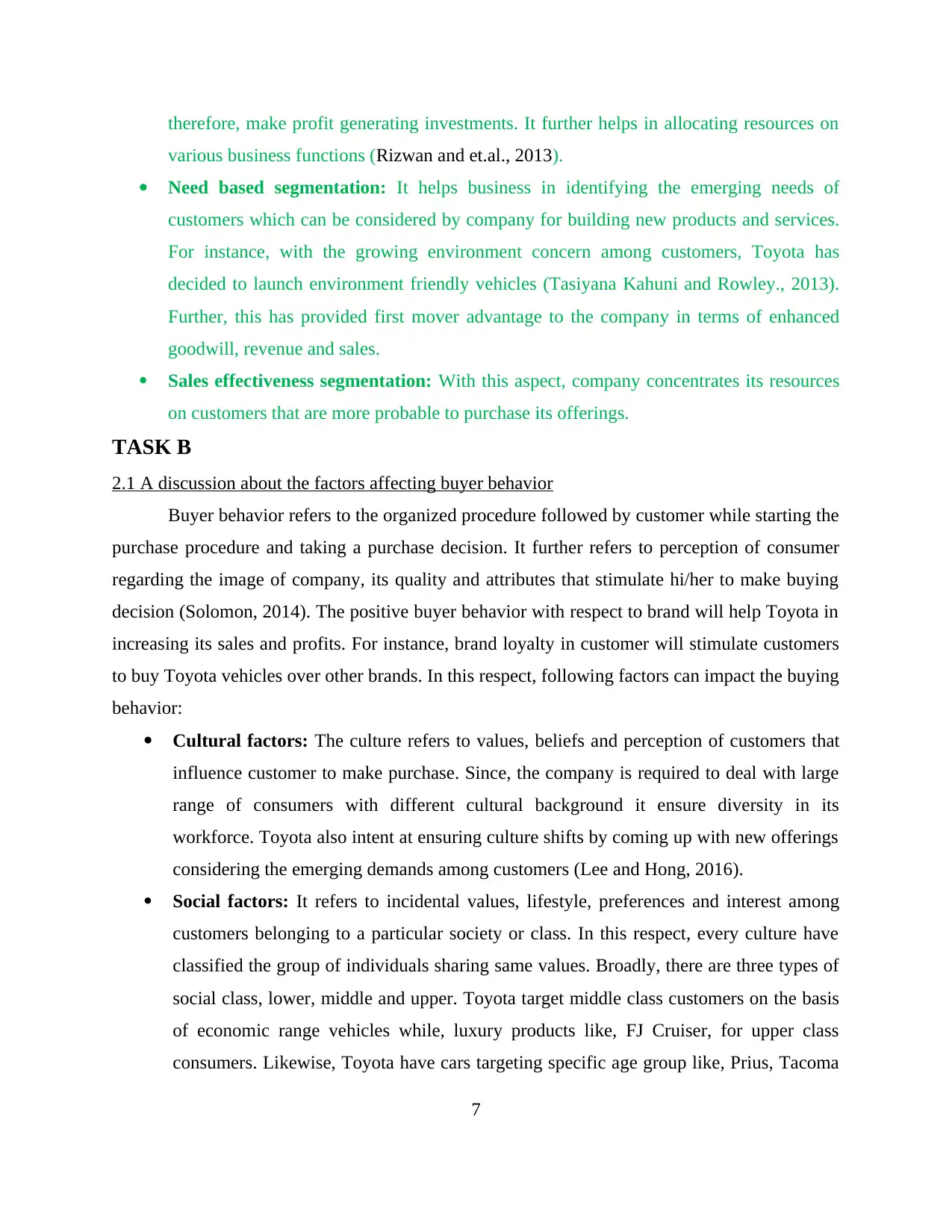
therefore, make profit generating investments. It further helps in allocating resources on
various business functions (Rizwan and et.al., 2013).
Need based segmentation: It helps business in identifying the emerging needs of
customers which can be considered by company for building new products and services.
For instance, with the growing environment concern among customers, Toyota has
decided to launch environment friendly vehicles (Tasiyana Kahuni and Rowley., 2013).
Further, this has provided first mover advantage to the company in terms of enhanced
goodwill, revenue and sales.
Sales effectiveness segmentation: With this aspect, company concentrates its resources
on customers that are more probable to purchase its offerings.
TASK B
2.1 A discussion about the factors affecting buyer behavior
Buyer behavior refers to the organized procedure followed by customer while starting the
purchase procedure and taking a purchase decision. It further refers to perception of consumer
regarding the image of company, its quality and attributes that stimulate hi/her to make buying
decision (Solomon, 2014). The positive buyer behavior with respect to brand will help Toyota in
increasing its sales and profits. For instance, brand loyalty in customer will stimulate customers
to buy Toyota vehicles over other brands. In this respect, following factors can impact the buying
behavior:
Cultural factors: The culture refers to values, beliefs and perception of customers that
influence customer to make purchase. Since, the company is required to deal with large
range of consumers with different cultural background it ensure diversity in its
workforce. Toyota also intent at ensuring culture shifts by coming up with new offerings
considering the emerging demands among customers (Lee and Hong, 2016).
Social factors: It refers to incidental values, lifestyle, preferences and interest among
customers belonging to a particular society or class. In this respect, every culture have
classified the group of individuals sharing same values. Broadly, there are three types of
social class, lower, middle and upper. Toyota target middle class customers on the basis
of economic range vehicles while, luxury products like, FJ Cruiser, for upper class
consumers. Likewise, Toyota have cars targeting specific age group like, Prius, Tacoma
7
various business functions (Rizwan and et.al., 2013).
Need based segmentation: It helps business in identifying the emerging needs of
customers which can be considered by company for building new products and services.
For instance, with the growing environment concern among customers, Toyota has
decided to launch environment friendly vehicles (Tasiyana Kahuni and Rowley., 2013).
Further, this has provided first mover advantage to the company in terms of enhanced
goodwill, revenue and sales.
Sales effectiveness segmentation: With this aspect, company concentrates its resources
on customers that are more probable to purchase its offerings.
TASK B
2.1 A discussion about the factors affecting buyer behavior
Buyer behavior refers to the organized procedure followed by customer while starting the
purchase procedure and taking a purchase decision. It further refers to perception of consumer
regarding the image of company, its quality and attributes that stimulate hi/her to make buying
decision (Solomon, 2014). The positive buyer behavior with respect to brand will help Toyota in
increasing its sales and profits. For instance, brand loyalty in customer will stimulate customers
to buy Toyota vehicles over other brands. In this respect, following factors can impact the buying
behavior:
Cultural factors: The culture refers to values, beliefs and perception of customers that
influence customer to make purchase. Since, the company is required to deal with large
range of consumers with different cultural background it ensure diversity in its
workforce. Toyota also intent at ensuring culture shifts by coming up with new offerings
considering the emerging demands among customers (Lee and Hong, 2016).
Social factors: It refers to incidental values, lifestyle, preferences and interest among
customers belonging to a particular society or class. In this respect, every culture have
classified the group of individuals sharing same values. Broadly, there are three types of
social class, lower, middle and upper. Toyota target middle class customers on the basis
of economic range vehicles while, luxury products like, FJ Cruiser, for upper class
consumers. Likewise, Toyota have cars targeting specific age group like, Prius, Tacoma
7
Paraphrase This Document
Need a fresh take? Get an instant paraphrase of this document with our AI Paraphraser
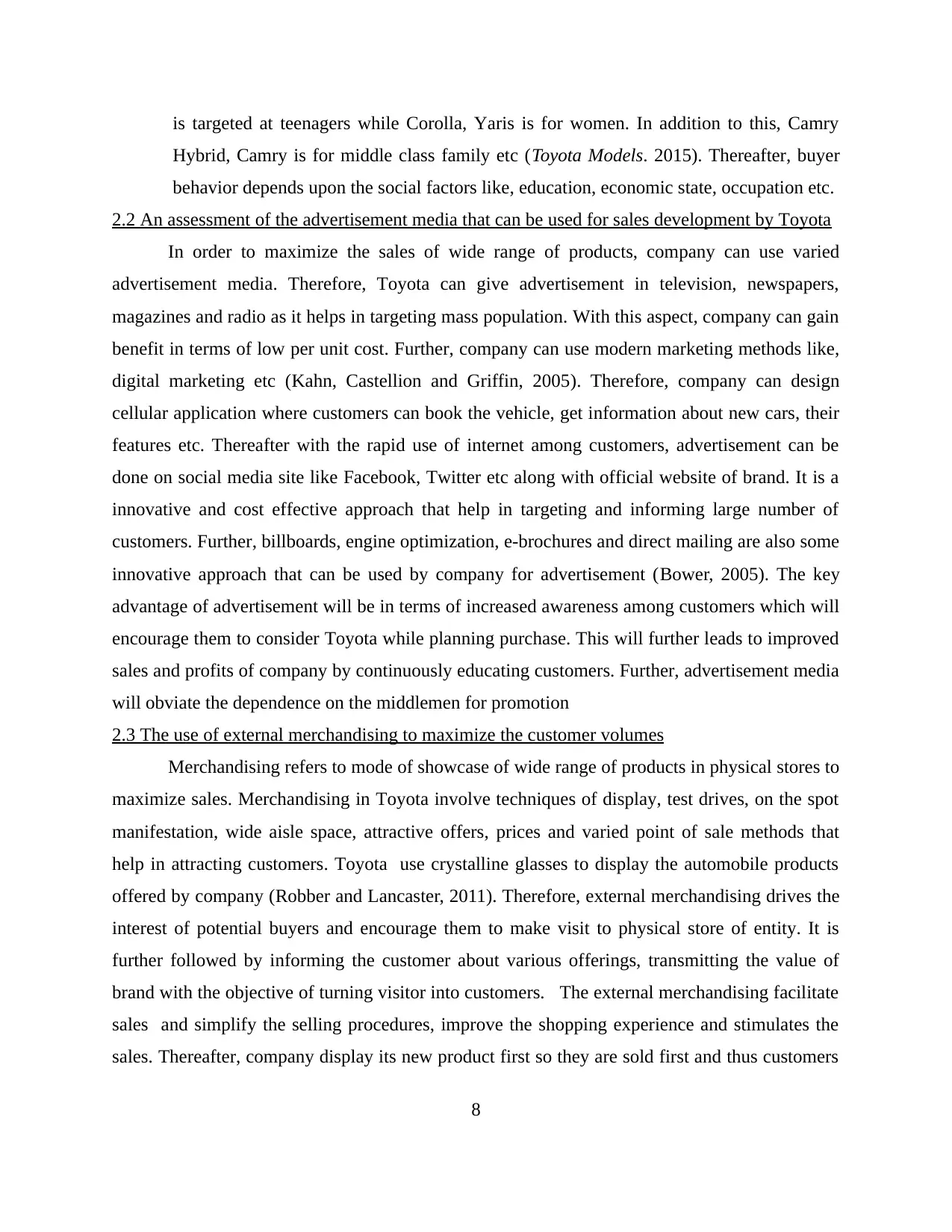
is targeted at teenagers while Corolla, Yaris is for women. In addition to this, Camry
Hybrid, Camry is for middle class family etc (Toyota Models. 2015). Thereafter, buyer
behavior depends upon the social factors like, education, economic state, occupation etc.
2.2 An assessment of the advertisement media that can be used for sales development by Toyota
In order to maximize the sales of wide range of products, company can use varied
advertisement media. Therefore, Toyota can give advertisement in television, newspapers,
magazines and radio as it helps in targeting mass population. With this aspect, company can gain
benefit in terms of low per unit cost. Further, company can use modern marketing methods like,
digital marketing etc (Kahn, Castellion and Griffin, 2005). Therefore, company can design
cellular application where customers can book the vehicle, get information about new cars, their
features etc. Thereafter with the rapid use of internet among customers, advertisement can be
done on social media site like Facebook, Twitter etc along with official website of brand. It is a
innovative and cost effective approach that help in targeting and informing large number of
customers. Further, billboards, engine optimization, e-brochures and direct mailing are also some
innovative approach that can be used by company for advertisement (Bower, 2005). The key
advantage of advertisement will be in terms of increased awareness among customers which will
encourage them to consider Toyota while planning purchase. This will further leads to improved
sales and profits of company by continuously educating customers. Further, advertisement media
will obviate the dependence on the middlemen for promotion
2.3 The use of external merchandising to maximize the customer volumes
Merchandising refers to mode of showcase of wide range of products in physical stores to
maximize sales. Merchandising in Toyota involve techniques of display, test drives, on the spot
manifestation, wide aisle space, attractive offers, prices and varied point of sale methods that
help in attracting customers. Toyota use crystalline glasses to display the automobile products
offered by company (Robber and Lancaster, 2011). Therefore, external merchandising drives the
interest of potential buyers and encourage them to make visit to physical store of entity. It is
further followed by informing the customer about various offerings, transmitting the value of
brand with the objective of turning visitor into customers. The external merchandising facilitate
sales and simplify the selling procedures, improve the shopping experience and stimulates the
sales. Thereafter, company display its new product first so they are sold first and thus customers
8
Hybrid, Camry is for middle class family etc (Toyota Models. 2015). Thereafter, buyer
behavior depends upon the social factors like, education, economic state, occupation etc.
2.2 An assessment of the advertisement media that can be used for sales development by Toyota
In order to maximize the sales of wide range of products, company can use varied
advertisement media. Therefore, Toyota can give advertisement in television, newspapers,
magazines and radio as it helps in targeting mass population. With this aspect, company can gain
benefit in terms of low per unit cost. Further, company can use modern marketing methods like,
digital marketing etc (Kahn, Castellion and Griffin, 2005). Therefore, company can design
cellular application where customers can book the vehicle, get information about new cars, their
features etc. Thereafter with the rapid use of internet among customers, advertisement can be
done on social media site like Facebook, Twitter etc along with official website of brand. It is a
innovative and cost effective approach that help in targeting and informing large number of
customers. Further, billboards, engine optimization, e-brochures and direct mailing are also some
innovative approach that can be used by company for advertisement (Bower, 2005). The key
advantage of advertisement will be in terms of increased awareness among customers which will
encourage them to consider Toyota while planning purchase. This will further leads to improved
sales and profits of company by continuously educating customers. Further, advertisement media
will obviate the dependence on the middlemen for promotion
2.3 The use of external merchandising to maximize the customer volumes
Merchandising refers to mode of showcase of wide range of products in physical stores to
maximize sales. Merchandising in Toyota involve techniques of display, test drives, on the spot
manifestation, wide aisle space, attractive offers, prices and varied point of sale methods that
help in attracting customers. Toyota use crystalline glasses to display the automobile products
offered by company (Robber and Lancaster, 2011). Therefore, external merchandising drives the
interest of potential buyers and encourage them to make visit to physical store of entity. It is
further followed by informing the customer about various offerings, transmitting the value of
brand with the objective of turning visitor into customers. The external merchandising facilitate
sales and simplify the selling procedures, improve the shopping experience and stimulates the
sales. Thereafter, company display its new product first so they are sold first and thus customers
8
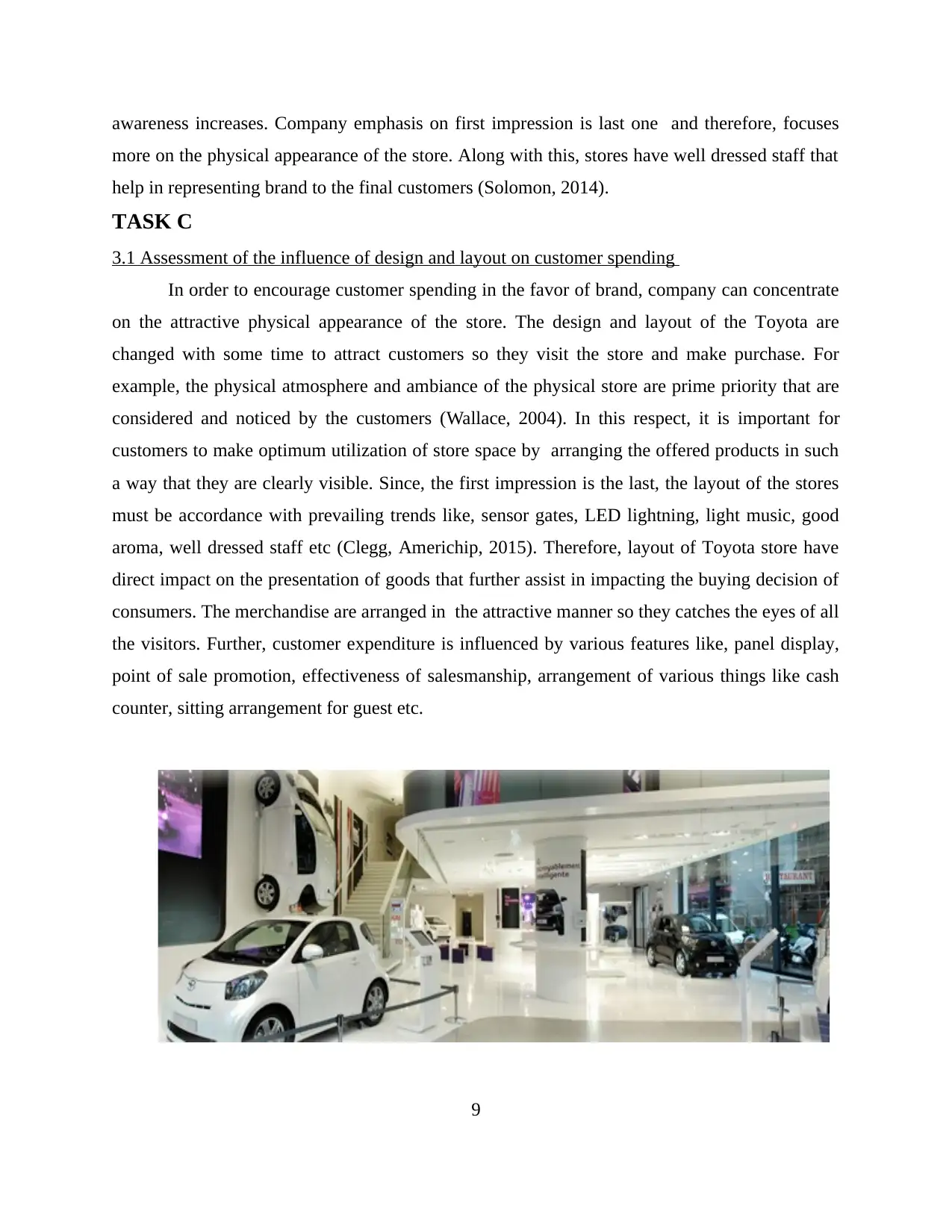
awareness increases. Company emphasis on first impression is last one and therefore, focuses
more on the physical appearance of the store. Along with this, stores have well dressed staff that
help in representing brand to the final customers (Solomon, 2014).
TASK C
3.1 Assessment of the influence of design and layout on customer spending
In order to encourage customer spending in the favor of brand, company can concentrate
on the attractive physical appearance of the store. The design and layout of the Toyota are
changed with some time to attract customers so they visit the store and make purchase. For
example, the physical atmosphere and ambiance of the physical store are prime priority that are
considered and noticed by the customers (Wallace, 2004). In this respect, it is important for
customers to make optimum utilization of store space by arranging the offered products in such
a way that they are clearly visible. Since, the first impression is the last, the layout of the stores
must be accordance with prevailing trends like, sensor gates, LED lightning, light music, good
aroma, well dressed staff etc (Clegg, Americhip, 2015). Therefore, layout of Toyota store have
direct impact on the presentation of goods that further assist in impacting the buying decision of
consumers. The merchandise are arranged in the attractive manner so they catches the eyes of all
the visitors. Further, customer expenditure is influenced by various features like, panel display,
point of sale promotion, effectiveness of salesmanship, arrangement of various things like cash
counter, sitting arrangement for guest etc.
9
more on the physical appearance of the store. Along with this, stores have well dressed staff that
help in representing brand to the final customers (Solomon, 2014).
TASK C
3.1 Assessment of the influence of design and layout on customer spending
In order to encourage customer spending in the favor of brand, company can concentrate
on the attractive physical appearance of the store. The design and layout of the Toyota are
changed with some time to attract customers so they visit the store and make purchase. For
example, the physical atmosphere and ambiance of the physical store are prime priority that are
considered and noticed by the customers (Wallace, 2004). In this respect, it is important for
customers to make optimum utilization of store space by arranging the offered products in such
a way that they are clearly visible. Since, the first impression is the last, the layout of the stores
must be accordance with prevailing trends like, sensor gates, LED lightning, light music, good
aroma, well dressed staff etc (Clegg, Americhip, 2015). Therefore, layout of Toyota store have
direct impact on the presentation of goods that further assist in impacting the buying decision of
consumers. The merchandise are arranged in the attractive manner so they catches the eyes of all
the visitors. Further, customer expenditure is influenced by various features like, panel display,
point of sale promotion, effectiveness of salesmanship, arrangement of various things like cash
counter, sitting arrangement for guest etc.
9
⊘ This is a preview!⊘
Do you want full access?
Subscribe today to unlock all pages.

Trusted by 1+ million students worldwide
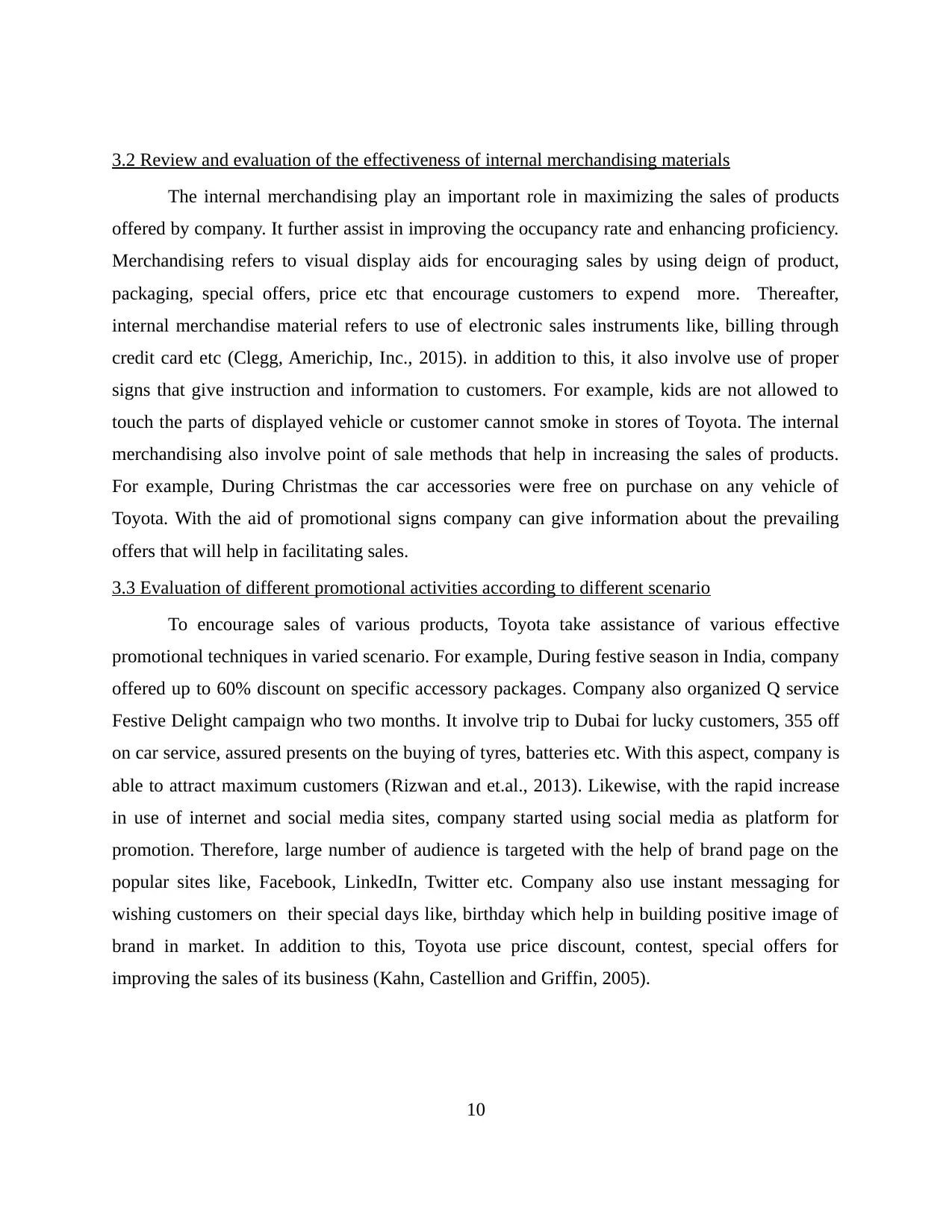
3.2 Review and evaluation of the effectiveness of internal merchandising materials
The internal merchandising play an important role in maximizing the sales of products
offered by company. It further assist in improving the occupancy rate and enhancing proficiency.
Merchandising refers to visual display aids for encouraging sales by using deign of product,
packaging, special offers, price etc that encourage customers to expend more. Thereafter,
internal merchandise material refers to use of electronic sales instruments like, billing through
credit card etc (Clegg, Americhip, Inc., 2015). in addition to this, it also involve use of proper
signs that give instruction and information to customers. For example, kids are not allowed to
touch the parts of displayed vehicle or customer cannot smoke in stores of Toyota. The internal
merchandising also involve point of sale methods that help in increasing the sales of products.
For example, During Christmas the car accessories were free on purchase on any vehicle of
Toyota. With the aid of promotional signs company can give information about the prevailing
offers that will help in facilitating sales.
3.3 Evaluation of different promotional activities according to different scenario
To encourage sales of various products, Toyota take assistance of various effective
promotional techniques in varied scenario. For example, During festive season in India, company
offered up to 60% discount on specific accessory packages. Company also organized Q service
Festive Delight campaign who two months. It involve trip to Dubai for lucky customers, 355 off
on car service, assured presents on the buying of tyres, batteries etc. With this aspect, company is
able to attract maximum customers (Rizwan and et.al., 2013). Likewise, with the rapid increase
in use of internet and social media sites, company started using social media as platform for
promotion. Therefore, large number of audience is targeted with the help of brand page on the
popular sites like, Facebook, LinkedIn, Twitter etc. Company also use instant messaging for
wishing customers on their special days like, birthday which help in building positive image of
brand in market. In addition to this, Toyota use price discount, contest, special offers for
improving the sales of its business (Kahn, Castellion and Griffin, 2005).
10
The internal merchandising play an important role in maximizing the sales of products
offered by company. It further assist in improving the occupancy rate and enhancing proficiency.
Merchandising refers to visual display aids for encouraging sales by using deign of product,
packaging, special offers, price etc that encourage customers to expend more. Thereafter,
internal merchandise material refers to use of electronic sales instruments like, billing through
credit card etc (Clegg, Americhip, Inc., 2015). in addition to this, it also involve use of proper
signs that give instruction and information to customers. For example, kids are not allowed to
touch the parts of displayed vehicle or customer cannot smoke in stores of Toyota. The internal
merchandising also involve point of sale methods that help in increasing the sales of products.
For example, During Christmas the car accessories were free on purchase on any vehicle of
Toyota. With the aid of promotional signs company can give information about the prevailing
offers that will help in facilitating sales.
3.3 Evaluation of different promotional activities according to different scenario
To encourage sales of various products, Toyota take assistance of various effective
promotional techniques in varied scenario. For example, During festive season in India, company
offered up to 60% discount on specific accessory packages. Company also organized Q service
Festive Delight campaign who two months. It involve trip to Dubai for lucky customers, 355 off
on car service, assured presents on the buying of tyres, batteries etc. With this aspect, company is
able to attract maximum customers (Rizwan and et.al., 2013). Likewise, with the rapid increase
in use of internet and social media sites, company started using social media as platform for
promotion. Therefore, large number of audience is targeted with the help of brand page on the
popular sites like, Facebook, LinkedIn, Twitter etc. Company also use instant messaging for
wishing customers on their special days like, birthday which help in building positive image of
brand in market. In addition to this, Toyota use price discount, contest, special offers for
improving the sales of its business (Kahn, Castellion and Griffin, 2005).
10
Paraphrase This Document
Need a fresh take? Get an instant paraphrase of this document with our AI Paraphraser
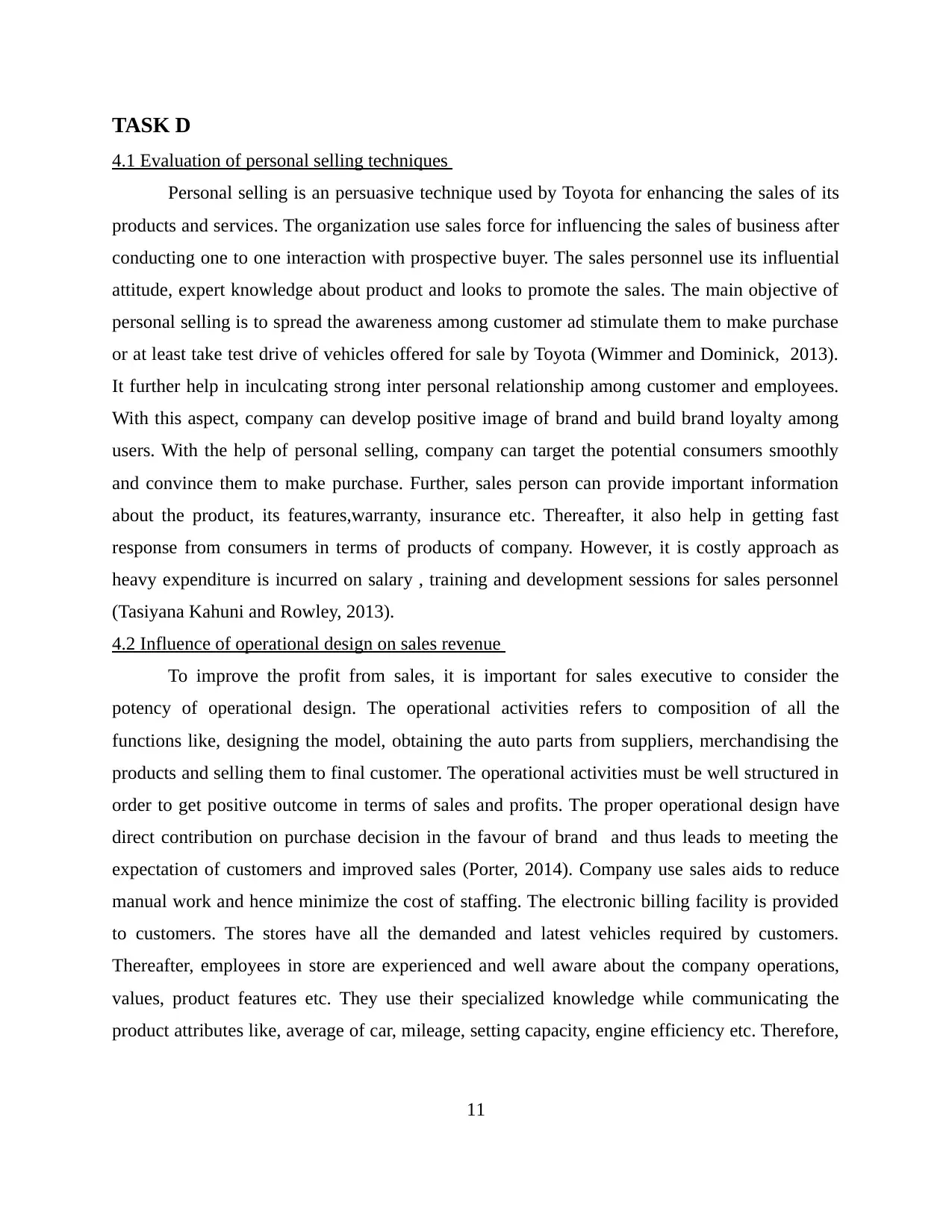
TASK D
4.1 Evaluation of personal selling techniques
Personal selling is an persuasive technique used by Toyota for enhancing the sales of its
products and services. The organization use sales force for influencing the sales of business after
conducting one to one interaction with prospective buyer. The sales personnel use its influential
attitude, expert knowledge about product and looks to promote the sales. The main objective of
personal selling is to spread the awareness among customer ad stimulate them to make purchase
or at least take test drive of vehicles offered for sale by Toyota (Wimmer and Dominick, 2013).
It further help in inculcating strong inter personal relationship among customer and employees.
With this aspect, company can develop positive image of brand and build brand loyalty among
users. With the help of personal selling, company can target the potential consumers smoothly
and convince them to make purchase. Further, sales person can provide important information
about the product, its features,warranty, insurance etc. Thereafter, it also help in getting fast
response from consumers in terms of products of company. However, it is costly approach as
heavy expenditure is incurred on salary , training and development sessions for sales personnel
(Tasiyana Kahuni and Rowley, 2013).
4.2 Influence of operational design on sales revenue
To improve the profit from sales, it is important for sales executive to consider the
potency of operational design. The operational activities refers to composition of all the
functions like, designing the model, obtaining the auto parts from suppliers, merchandising the
products and selling them to final customer. The operational activities must be well structured in
order to get positive outcome in terms of sales and profits. The proper operational design have
direct contribution on purchase decision in the favour of brand and thus leads to meeting the
expectation of customers and improved sales (Porter, 2014). Company use sales aids to reduce
manual work and hence minimize the cost of staffing. The electronic billing facility is provided
to customers. The stores have all the demanded and latest vehicles required by customers.
Thereafter, employees in store are experienced and well aware about the company operations,
values, product features etc. They use their specialized knowledge while communicating the
product attributes like, average of car, mileage, setting capacity, engine efficiency etc. Therefore,
11
4.1 Evaluation of personal selling techniques
Personal selling is an persuasive technique used by Toyota for enhancing the sales of its
products and services. The organization use sales force for influencing the sales of business after
conducting one to one interaction with prospective buyer. The sales personnel use its influential
attitude, expert knowledge about product and looks to promote the sales. The main objective of
personal selling is to spread the awareness among customer ad stimulate them to make purchase
or at least take test drive of vehicles offered for sale by Toyota (Wimmer and Dominick, 2013).
It further help in inculcating strong inter personal relationship among customer and employees.
With this aspect, company can develop positive image of brand and build brand loyalty among
users. With the help of personal selling, company can target the potential consumers smoothly
and convince them to make purchase. Further, sales person can provide important information
about the product, its features,warranty, insurance etc. Thereafter, it also help in getting fast
response from consumers in terms of products of company. However, it is costly approach as
heavy expenditure is incurred on salary , training and development sessions for sales personnel
(Tasiyana Kahuni and Rowley, 2013).
4.2 Influence of operational design on sales revenue
To improve the profit from sales, it is important for sales executive to consider the
potency of operational design. The operational activities refers to composition of all the
functions like, designing the model, obtaining the auto parts from suppliers, merchandising the
products and selling them to final customer. The operational activities must be well structured in
order to get positive outcome in terms of sales and profits. The proper operational design have
direct contribution on purchase decision in the favour of brand and thus leads to meeting the
expectation of customers and improved sales (Porter, 2014). Company use sales aids to reduce
manual work and hence minimize the cost of staffing. The electronic billing facility is provided
to customers. The stores have all the demanded and latest vehicles required by customers.
Thereafter, employees in store are experienced and well aware about the company operations,
values, product features etc. They use their specialized knowledge while communicating the
product attributes like, average of car, mileage, setting capacity, engine efficiency etc. Therefore,
11
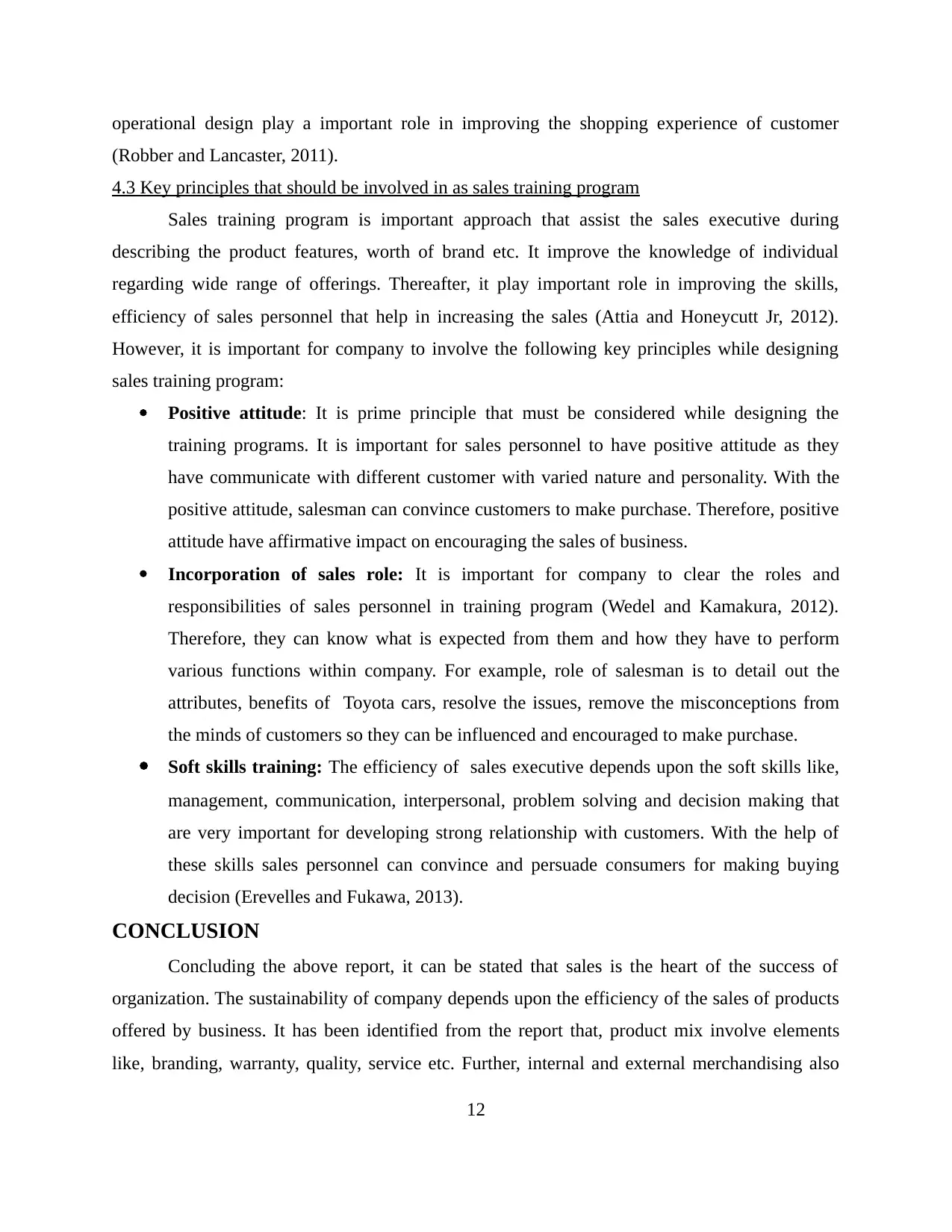
operational design play a important role in improving the shopping experience of customer
(Robber and Lancaster, 2011).
4.3 Key principles that should be involved in as sales training program
Sales training program is important approach that assist the sales executive during
describing the product features, worth of brand etc. It improve the knowledge of individual
regarding wide range of offerings. Thereafter, it play important role in improving the skills,
efficiency of sales personnel that help in increasing the sales (Attia and Honeycutt Jr, 2012).
However, it is important for company to involve the following key principles while designing
sales training program:
Positive attitude: It is prime principle that must be considered while designing the
training programs. It is important for sales personnel to have positive attitude as they
have communicate with different customer with varied nature and personality. With the
positive attitude, salesman can convince customers to make purchase. Therefore, positive
attitude have affirmative impact on encouraging the sales of business.
Incorporation of sales role: It is important for company to clear the roles and
responsibilities of sales personnel in training program (Wedel and Kamakura, 2012).
Therefore, they can know what is expected from them and how they have to perform
various functions within company. For example, role of salesman is to detail out the
attributes, benefits of Toyota cars, resolve the issues, remove the misconceptions from
the minds of customers so they can be influenced and encouraged to make purchase.
Soft skills training: The efficiency of sales executive depends upon the soft skills like,
management, communication, interpersonal, problem solving and decision making that
are very important for developing strong relationship with customers. With the help of
these skills sales personnel can convince and persuade consumers for making buying
decision (Erevelles and Fukawa, 2013).
CONCLUSION
Concluding the above report, it can be stated that sales is the heart of the success of
organization. The sustainability of company depends upon the efficiency of the sales of products
offered by business. It has been identified from the report that, product mix involve elements
like, branding, warranty, quality, service etc. Further, internal and external merchandising also
12
(Robber and Lancaster, 2011).
4.3 Key principles that should be involved in as sales training program
Sales training program is important approach that assist the sales executive during
describing the product features, worth of brand etc. It improve the knowledge of individual
regarding wide range of offerings. Thereafter, it play important role in improving the skills,
efficiency of sales personnel that help in increasing the sales (Attia and Honeycutt Jr, 2012).
However, it is important for company to involve the following key principles while designing
sales training program:
Positive attitude: It is prime principle that must be considered while designing the
training programs. It is important for sales personnel to have positive attitude as they
have communicate with different customer with varied nature and personality. With the
positive attitude, salesman can convince customers to make purchase. Therefore, positive
attitude have affirmative impact on encouraging the sales of business.
Incorporation of sales role: It is important for company to clear the roles and
responsibilities of sales personnel in training program (Wedel and Kamakura, 2012).
Therefore, they can know what is expected from them and how they have to perform
various functions within company. For example, role of salesman is to detail out the
attributes, benefits of Toyota cars, resolve the issues, remove the misconceptions from
the minds of customers so they can be influenced and encouraged to make purchase.
Soft skills training: The efficiency of sales executive depends upon the soft skills like,
management, communication, interpersonal, problem solving and decision making that
are very important for developing strong relationship with customers. With the help of
these skills sales personnel can convince and persuade consumers for making buying
decision (Erevelles and Fukawa, 2013).
CONCLUSION
Concluding the above report, it can be stated that sales is the heart of the success of
organization. The sustainability of company depends upon the efficiency of the sales of products
offered by business. It has been identified from the report that, product mix involve elements
like, branding, warranty, quality, service etc. Further, internal and external merchandising also
12
⊘ This is a preview!⊘
Do you want full access?
Subscribe today to unlock all pages.

Trusted by 1+ million students worldwide
1 out of 15
Related Documents
Your All-in-One AI-Powered Toolkit for Academic Success.
+13062052269
info@desklib.com
Available 24*7 on WhatsApp / Email
![[object Object]](/_next/static/media/star-bottom.7253800d.svg)
Unlock your academic potential
Copyright © 2020–2026 A2Z Services. All Rights Reserved. Developed and managed by ZUCOL.





